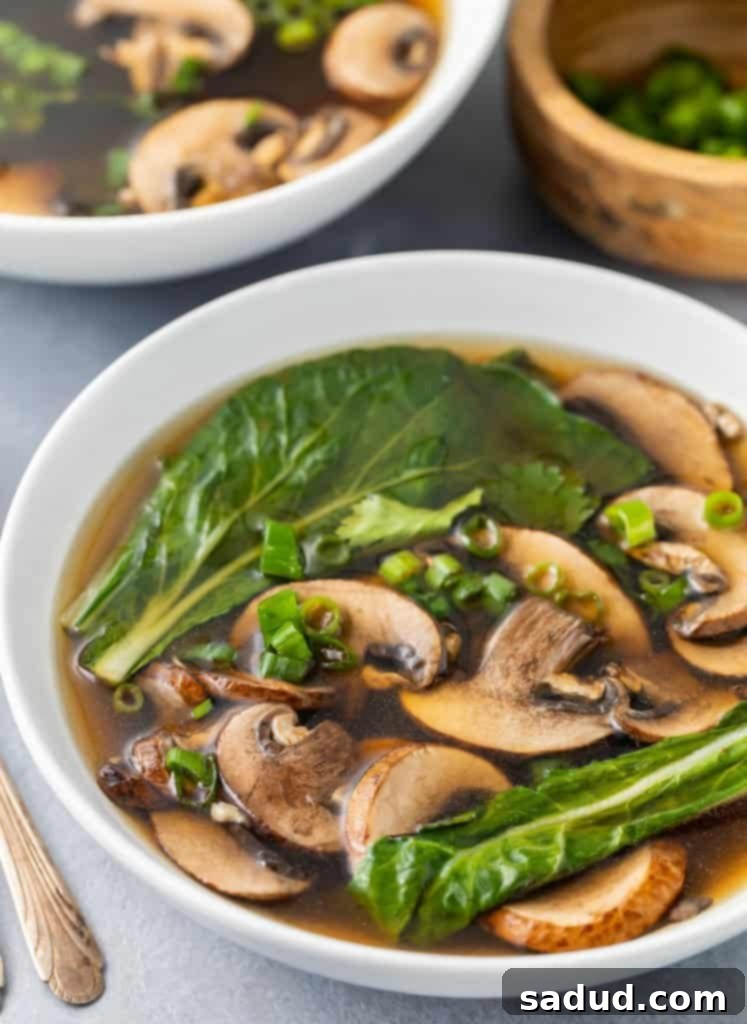Nourishing & Quick: The Ultimate Vegan Chinese Vegetable Soup Recipe
Searching for a meal that’s both incredibly satisfying and wonderfully quick to prepare? Look no further than this delightful Chinese vegetable soup. It’s a vibrant, light-yet-filling dish bursting with an array of fresh flavors and essential nutrients. Perfect for a busy weeknight, a light lunch, or a comforting dinner, this soup comes together in less than 20 minutes, proving that healthy eating doesn’t have to be complicated or time-consuming. What’s more, it’s naturally vegan, making it an excellent choice for plant-based diets, and can be easily adapted to be completely gluten-free.
This recipe offers a beautiful blend of traditional Asian ingredients, simmered to perfection in a savory broth. Each spoonful provides a harmonious balance of textures and tastes, from the tender crispness of bok choy to the earthy notes of mushrooms and the subtle sweetness of carrots. Whether you’re a seasoned cook or a kitchen novice, you’ll find this recipe straightforward and rewarding. Get ready to enjoy a bowl of pure comfort and goodness!

What Makes This Chinese Vegetable Soup So Irresistibly Good
This isn’t just any vegetable soup; it’s a culinary experience designed for flavor, health, and convenience. Here’s what sets our Chinese vegetable soup apart:
- Packed with Hearty, Nutritious Veggies: Unlike some light soups that leave you wanting more, this recipe is loaded with a generous amount of fresh vegetables like bok choy, mushrooms, and carrots. These ingredients provide substantial texture and volume, ensuring you feel truly satiated. It’s a light, flavorful brothy soup that delivers robust satisfaction, leaving you feeling comfortably full without any heaviness. Each vegetable contributes unique vitamins, minerals, and fiber, making every spoonful a boost for your well-being and supporting a balanced diet.
- Completely Vegan and Rich in Plant-Based Protein: If you’re looking to incorporate more plant-based meals into your diet – whether for a single meal, a month-long challenge, or a lifetime commitment – this soup is an outstanding choice. Our Chinese vegetable soup is 100% vegan and surprisingly protein-rich for a vegetable-focused dish, offering approximately 11 grams of protein per serving. This makes it a great option for supporting muscle health and sustained energy, all from plant sources. The combination of various vegetables and the flavorful broth creates a complex profile that even meat-eaters will thoroughly enjoy.
- Whip It Up in Record Time: Life gets busy, and sometimes you need a quick yet wholesome meal. This Chinese vegetable soup comes together in almost no time at all. With a total prep and cook time of under 20 minutes, it’s the perfect solution for those evenings when you need something delicious, easy, and nutritious on the table fast. It requires minimal chopping and simple cooking steps, making it accessible for everyone, regardless of cooking skill, without compromising on taste or nutritional value.
- Naturally Gluten-Free (with a simple swap): For those with gluten sensitivities or following a gluten-free diet, this soup is a dream come true. By simply ensuring your soy sauce is gluten-free (or using tamari) and carefully checking your vegetable broth ingredients, this soup is entirely safe and delicious. There’s no need for special, complicated modifications or hunting down obscure ingredients; just enjoy a flavorful, worry-free meal that fits your dietary needs.
- Customizable and Versatile: One of the best aspects of this soup is its adaptability. Feel free to add other vegetables you have on hand, adjust the spice level to your preference, or include different plant-based protein sources like cubed tofu or tempeh. It’s a fantastic base recipe that encourages culinary creativity and caters to individual preferences, allowing you to make it uniquely yours every time.
Key Ingredients for an Authentic & Flavorful Chinese Vegetable Soup
The magic of this soup lies in its simple yet powerful ingredients. Each component plays a vital role in creating its distinctive taste and texture, ensuring a truly satisfying experience:
Bok Choy – This traditional Chinese leafy green vegetable is a cornerstone of this soup, providing both structure and a delicate flavor. It offers a unique taste profile often described as a mild cross between cabbage, celery, and a hint of cucumber. When cooked briefly, its crisp white stems become tender-crisp while the vibrant green leaves wilt beautifully, absorbing the rich flavors of the broth. Bok choy is not only delicious but also incredibly nutritious, packed with vitamins A, C, and K, as well as folate and calcium, making it a fantastic addition to any healthy diet. When selecting bok choy, look for vibrant green leaves and firm, white stems. Avoid any heads with yellowing leaves or soft spots, as these are signs of age. If fresh bok choy is not available, Napa cabbage is an excellent substitute, offering a similar mild flavor and tender texture.
Vegetable Broth – The broth forms the flavorful foundation of our soup, dictating much of its savory depth. We highly recommend opting for a high-quality, low-sodium vegetable broth, as we’ll be adding our own salt and soy sauce. This allows you precise control over the overall seasoning, preventing the soup from becoming overly salty. A good quality broth makes all the difference in the final flavor! If you’re not strictly vegan or vegetarian, you can certainly use chicken broth for a richer, more savory base, or even a light beef broth if you prefer a different depth of flavor. For an extra layer of umami, consider using a mushroom-based broth. For the freshest and most natural taste, you could even try making your own homemade vegetable broth from scraps.
Mushrooms – Sliced mushrooms add a wonderful earthy flavor and a satisfying, somewhat meaty texture that enhances the soup’s heartiness. White button mushrooms are readily available and work well, but cremini (baby bella) or shiitake mushrooms will deepen the umami profile significantly. Shiitake mushrooms, in particular, will provide a more intense, authentic Asian flavor. Beyond their taste, mushrooms are also a good source of B vitamins, selenium, and antioxidants, contributing to the overall nutritional value of the dish.
Carrots – Shredded carrots introduce a touch of natural sweetness and a vibrant pop of orange color to the soup, making it visually appealing. They soften slightly when cooked, adding a pleasant texture contrast to the other vegetables. Carrots are, of course, well-known for their high beta-carotene content, which is crucial for eye health, and they also provide beneficial dietary fiber.
Soy Sauce – This indispensable ingredient brings a crucial umami depth and savory, salty flavor that is characteristic of authentic Chinese cuisine. It’s essential for building that signature Asian taste. Be sure to use a low-sodium variety to better manage the soup’s overall saltiness. If you need the soup to be completely gluten-free, always substitute traditional soy sauce with tamari, which offers a very similar flavor profile without the wheat content.
Garlic & Fresh Ginger – These aromatic powerhouses form the backbone of the soup’s fresh and zesty flavor profile. Freshly minced garlic adds a pungent, savory depth that is comforting and familiar, while fresh minced ginger provides a warm, slightly spicy, and incredibly fragrant quality that brightens the entire dish. Don’t skip these; they are absolutely essential for achieving that authentic and invigorating Chinese taste!
Sesame Oil – A small drizzle of toasted sesame oil, added at the very end of cooking, is a game-changer. It imparts a distinctive nutty aroma and a rich, complex finishing flavor that ties all the ingredients together harmoniously. Use it sparingly, as its flavor is potent, and a little goes a long way to make a significant impact.
Salt & Pepper – These are essential for fine-tuning the seasoning to your exact taste. Starting with a base amount and then adjusting allows you to perfect the flavor balance of your soup. Remember that individual preferences vary, and a perfectly seasoned soup is key to maximum enjoyment.
Chef’s Tips & Tricks for the Best Chinese Vegetable Soup
Elevate your homemade Chinese vegetable soup from good to extraordinary with these expert tips and thoughtful additions:
- For an extra layer of bright, tangy flavor, try adding a little rice vinegar. Just a splash – typically about a teaspoon or two per serving – stirred in at the very end of cooking can significantly brighten the soup and perfectly balance the savory notes, giving it a more complex and authentic taste profile. It’s a small addition that makes a big difference.
- To ensure you’re getting the freshest and most flavorful bok choy, look for vibrant green leaves with firm, tightly fitting white stems. The leaves should appear crisp and healthy, without any signs of yellowing, bruising, or wilting. Avoid bok choy where the leaves are already separating or look limp, as these are clear indicators of age and will result in a less pleasant texture and flavor.
- Do not overcook the bok choy. This delicate vegetable only requires a few minutes of simmering to soften to an ideal tender-crisp texture. Overcooked bok choy will quickly become mushy, lose its appealing bite, and its vibrant color will dull, diminishing the overall appeal of your soup. You want it softened, but still with a slight, satisfying bite!
- If you want your Chinese vegetable soup to have even more substance and transform it into a heartier, more complete meal, you can prepare a package of thin rice noodles (vermicelli) or even wider rice noodles while your broth is simmering on the stove. Cook them separately according to package directions, then divide the cooked noodles evenly between two large serving bowls. Ladle the hot soup generously over the noodles for a truly satisfying and complete meal. Other noodle options like ramen noodles (ensure to discard the seasoning packet), glass noodles, or even udon can also work beautifully.
- Adjust the Seasoning to Your Liking: Always taste the soup before serving and adjust the salt, pepper, or soy sauce as needed. Remember that individual preferences for saltiness and overall flavor intensity vary, and a perfectly seasoned soup is key to maximum enjoyment. If you’re using a high-sodium broth, you might need less added salt and soy sauce, so always taste as you go.
- Boost the Protein Content: While this soup is already protein-rich for a vegetable dish, you can easily add more plant-based protein to make it even more substantial. Cubed firm or extra-firm tofu (lightly pressed and perhaps pan-fried or baked for a crispy texture, or simply added directly to the simmering broth), shelled edamame, or even a handful of cooked lentils can make it even more filling and nutritious.
- Add a Spicy Kick: If you enjoy a bit of heat and want to liven up your soup, stir in a dash of chili garlic sauce, a squeeze of Sriracha, or a pinch of red pepper flakes along with the soy sauce and aromatics. Start with a small amount and add more gradually to achieve your desired level of spice, tasting as you go.
- Garnish Generously: Fresh garnishes like finely chopped scallions (green onions) and fresh cilantro aren’t just for looks; they add a burst of vibrant freshness, aromatic depth, and an extra layer of flavor that truly elevates the soup. Don’t skip them! Toasted sesame seeds can also add a nice textural crunch and nutty essence.
- Experiment with Vegetable Variety: Feel free to experiment with other quick-cooking vegetables you enjoy or have on hand. Sliced snow peas, water chestnuts, bamboo shoots, corn kernels, or thinly sliced bell peppers can all be wonderful additions, contributing different textures, colors, and nutrients to your custom soup creation.
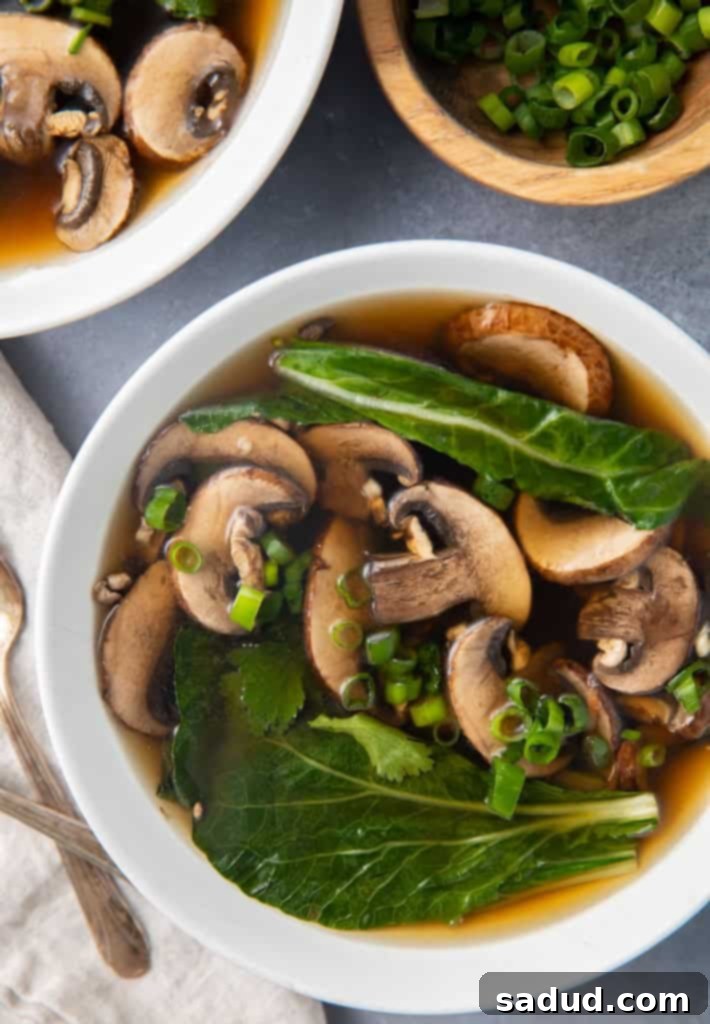
Serving Suggestions for Your Chinese Vegetable Soup
This versatile soup is absolutely delicious and satisfying on its own, but it also pairs wonderfully with other dishes, making it suitable for a range of meal occasions. Here are a few ideas to help you make it a more complete and diverse meal:
- With Noodles: As mentioned in our chef’s tips, incorporating rice noodles or other Asian-style noodles is a fantastic way to transform this light broth into a hearty and filling noodle bowl. The noodles soak up the flavorful broth, creating a comforting and substantial dish.
- Alongside Rice: Serve a bowl of fluffy jasmine rice or wholesome brown rice on the side. You can enjoy the soup and rice separately, or for a more integrated experience, spoon the flavorful soup generously over the rice, allowing it to absorb all the delicious flavors.
- Crispy Spring Rolls or Egg Rolls: Complement the delicate flavors of the soup with the delightful crunch of vegetarian spring rolls or savory egg rolls for an authentic and satisfying Asian dining experience.
- Light Side Salad: A simple, fresh green salad tossed with a tangy sesame ginger dressing can add a refreshing contrast to the warm soup, providing a crisp and vibrant element to your meal.
- Steamed Buns (Bao Buns): Soft, pillowy steamed buns, especially those filled with flavorful vegetables or seasoned tofu, make an excellent and delightful accompaniment to this light soup.
- As an Appetizer: If you’re planning a larger Asian-themed feast, serve smaller portions of this Chinese vegetable soup as a warming and flavorful starter to whet your guests’ appetites.
The Health Benefits of This Delicious Soup
Beyond its incredible taste and ease of preparation, this Chinese vegetable soup is a true nutritional powerhouse, offering a multitude of benefits for your health and well-being:
- Rich in Essential Vitamins and Minerals: The diverse array of vegetables ensures a high intake of vital nutrients. Bok choy is an excellent source of vitamins A, C, and K, crucial for immunity, skin health, and bone strength. Carrots provide abundant beta-carotene, important for vision, while mushrooms contribute B vitamins, selenium, and potassium, supporting energy and overall bodily functions.
- High in Dietary Fiber: The generous portion of vegetables in this soup guarantees a good intake of dietary fiber. Fiber is essential for promoting healthy digestion, helping to regulate blood sugar levels, and contributing significantly to that satisfying feeling of fullness, which can aid in weight management.
- Low in Calories, High in Satisfaction: This soup is commendably light in calories but heavy on flavor, nutrients, and satiating qualities. This makes it an ideal choice for those looking to manage their weight or simply maintain a healthy diet without feeling deprived or compromising on taste.
- Excellent Hydration: As a broth-based soup, it contributes significantly to your daily fluid intake. Staying well-hydrated is essential for all bodily functions, including metabolism, temperature regulation, and nutrient transport.
- Abundant Antioxidant Properties: Many of the ingredients, including the various vegetables, garlic, and ginger, are rich in powerful antioxidants. These compounds help combat oxidative stress, protect your cells from damage caused by free radicals, and can reduce inflammation throughout the body.
- Supports Plant-Based Eating: Being naturally vegan, this soup is perfect for those following a plant-based diet, providing a delicious and complete meal that avoids animal products while still offering robust nutrition.
Storage and Reheating
This delightful Chinese vegetable soup makes for fantastic leftovers, perfect for quick and healthy meals throughout the week, or even to enjoy later. Proper storage and reheating ensure you can savor its delicious flavors for days to come:
- Storage: Allow the soup to cool completely to room temperature before transferring it to an airtight container. Storing hot soup directly in the refrigerator can raise the internal temperature of your fridge, affecting other foods. Once cooled, it can be safely stored in the refrigerator for up to 3-4 days.
- Freezing: The soup, particularly the broth and vegetables (without any added fresh noodles), freezes exceptionally well. Portion the cooled soup into freezer-safe containers or heavy-duty freezer bags, leaving a little headspace for expansion. It can be stored in the freezer for up to 2-3 months. When ready to enjoy, thaw it overnight in the refrigerator before reheating.
- Reheating: For best results, gently reheat the soup on the stovetop over medium-low heat. Stir occasionally until it reaches your desired serving temperature. Avoid boiling it vigorously, especially if it contains bok choy, as this can lead to mushy vegetables and a diminished texture. If you initially added noodles to your soup, they might become a bit soft after reheating. For the freshest texture, it’s best to cook fresh noodles separately and add them to reheated soup.
More Tasty & Healthy Soup Recipes to Explore
If you’ve thoroughly enjoyed the comforting flavors and healthful benefits of this Chinese Vegetable Soup, you’re in for a treat! We have an extensive collection of delicious and easy-to-make soup recipes that cater to various tastes and dietary needs. From hearty stews to light broths, there’s something for everyone to discover and love. Dive into these other popular options to expand your soup repertoire and find your next favorite:
- Keto Egg Drop Soup: A low-carb, high-protein twist on a classic Chinese favorite, perfect for a quick and satisfying meal that fits a ketogenic lifestyle.
- Smoked Turkey and White Bean Soup: A hearty, smoky, and incredibly filling soup ideal for cooler weather, utilizing rich flavors and wholesome ingredients.
- Creamy Vegan Potato Soup: A comforting and dairy-free version of a beloved classic, offering all the richness without the cream.
- Healthy Zuppa Toscana (Whole30, Paleo, Dairy Free): A wholesome and compliant take on the popular Italian soup, making it accessible for specific dietary needs without sacrificing flavor.
- Best Ever Tom Kha Gai Soup: Experience the exotic, creamy, and aromatic flavors of this traditional Thai coconut chicken soup, a true delight for your taste buds.
- Traditional Irish Potato Soup: A simple, rustic, and incredibly comforting potato soup, perfect for a cozy night in.
If you loved this healthy and easy Chinese Vegetable Soup recipe as much as we did, don’t forget to leave us a review below with a star rating. Your feedback helps us grow and inspires other home cooks! ★ Follow Easy Healthy Recipes on Pinterest, Facebook, and Instagram, too, for daily recipe inspiration and behind-the-scenes glimpses!
For more delightful and diverse recipes, make sure to visit our sister sites, 40 Aprons for healthy whole-food recipes and Easy Cheap Recipes for budget-friendly meal ideas that don’t compromise on flavor!
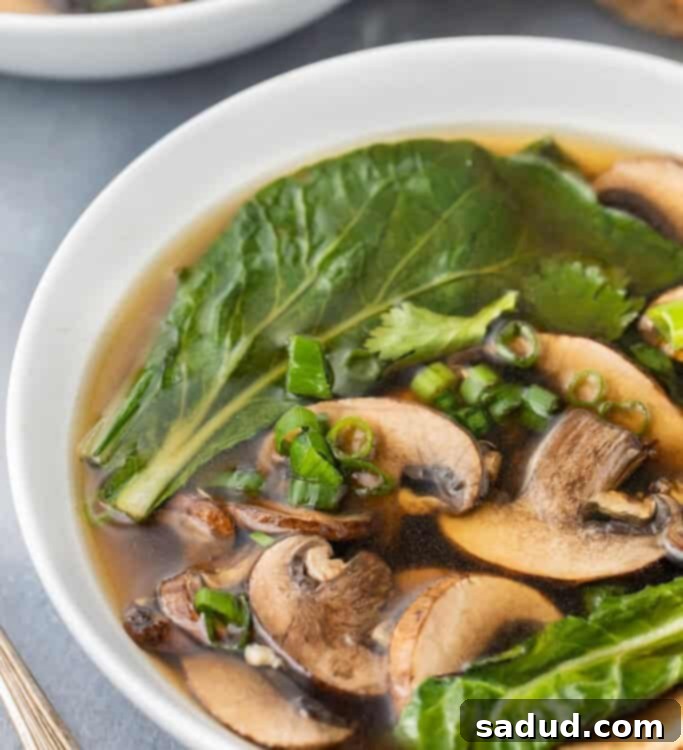
Quick & Healthy Chinese Vegetable Soup (Vegan, Gluten-Free Option)
 Cheryl Malik
Cheryl Malik
Print Recipe
SaveSaved!
Ingredients
- 2 cups water
- 4 cups vegetable broth (low sodium recommended for best flavor control)
- 1 head bok choy thoroughly washed and sliced into 1-inch pieces
- 8 ounces mushrooms sliced (white button, cremini, or shiitake work well for different flavor depths)
- 1 cup carrots shredded or thinly sliced into matchsticks for quick cooking
- 2 teaspoons soy sauce (use tamari for a gluten-free option)
- 1 clove garlic freshly minced, or 1/2 teaspoon garlic powder
- 1 teaspoon fresh ginger finely minced, for a zesty kick
- ½ teaspoon sesame oil (for a nutty finishing aroma)
- 2 teaspoons salt plus more as needed, to taste
- pepper freshly ground, to taste
- fresh cilantro chopped, optional, for garnish
- fresh scallions sliced, optional, for garnish
Equipment
-
medium saucepan (or large pot if making more servings)
Instructions
-
In a large pot or medium saucepan, combine the specified amounts of water and vegetable broth. Bring this liquid mixture to a rolling boil over medium-high heat. Ensure the broth is hot and simmering vigorously before proceeding to the next step, as this helps cook the vegetables quickly and evenly.
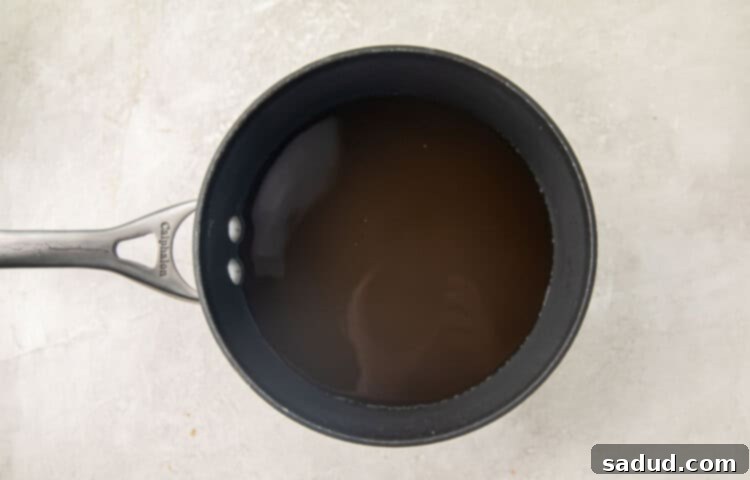
-
Once the broth is boiling, reduce the heat to low to maintain a gentle, steady simmer. Carefully add the prepared sliced bok choy, shredded carrots, and sliced mushrooms to the pot. Stir gently to ensure all the vegetables are submerged and cooking in the hot broth. Cook for approximately 2 minutes. During this time, the vegetables should just begin to soften while still retaining a slight, appealing crunch, particularly the bok choy stems.
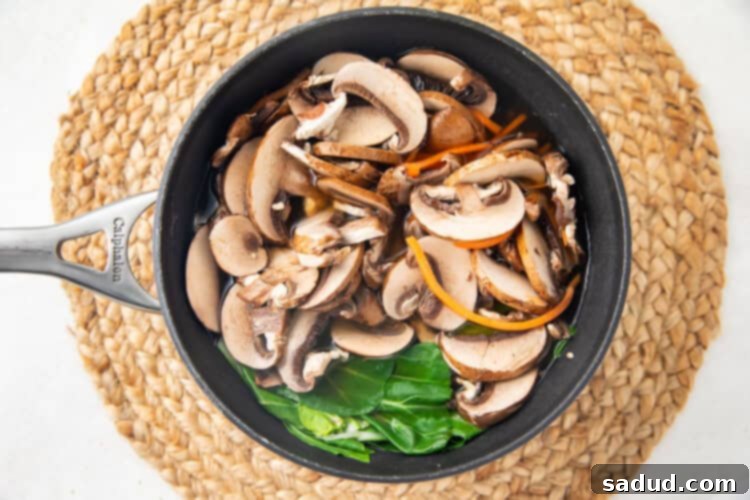
-
Now, it’s time to infuse more distinct Asian flavors into your soup. Add the soy sauce (or tamari if gluten-free), freshly minced garlic, finely minced fresh ginger, and the ½ teaspoon of aromatic sesame oil to the simmering soup. Stir everything together thoroughly, ensuring the flavors are well distributed. Continue to cook for an additional 2-5 minutes, or until the bok choy has softened to your preferred texture, being careful not to overcook it into a mushy state. Taste the soup at this stage and adjust any seasonings as needed before the final step.
-
Remove the pot from the heat. Stir in the initial 2 teaspoons of salt and a generous amount of freshly ground black pepper. Taste the soup again to confirm the seasoning is perfect for your palate; add more salt or pepper if desired. Carefully portion the hot, flavorful soup into individual serving bowls. For an extra touch of freshness, vibrant color, and an aromatic boost, garnish generously with fresh chopped cilantro and thinly sliced scallions. Serve your delicious and wholesome Chinese Vegetable Soup warm and enjoy immediately!
Notes
- Make it Gluten-Free: To ensure this soup is completely gluten-free, always double-check the labels of your vegetable broth. Some brands might include gluten-containing ingredients like hydrolyzed wheat protein. Additionally, make sure to use a certified gluten-free soy sauce or substitute it entirely with tamari, which is a popular and readily available gluten-free alternative to traditional soy sauce.
- Spice it Up: For those who love a little heat and want to add an extra kick to their soup, consider stirring in a pinch of red pepper flakes or a teaspoon of chili garlic sauce (like sriracha or sambal oelek) along with the soy sauce and aromatics in Step 3. Adjust the amount to your personal spice preference.
- Adding Noodles: If you plan on serving this soup with noodles to make it a more substantial meal, it’s best to prepare them separately according to their package instructions. Divide the cooked noodles among your serving bowls and then ladle the hot soup over them just before serving. This method prevents the noodles from becoming overly soft or mushy if you happen to have any leftovers.
- Storage & Meal Prep: Leftover Chinese Vegetable Soup stores wonderfully. Allow the soup to cool completely before transferring it to an airtight container. It can then be stored in the refrigerator for up to 3-4 days, making it an excellent option for healthy meal prep throughout your week.
Nutrition Information
The number of total servings shown is approximate. Actual number of servings will depend on your preferred portion sizes and the density of vegetables used.
Nutritional values provided are general guidelines and reflect information for 1 serving using the ingredients listed, not including any optional ingredients or additions like noodles. Actual macros and nutritional content may vary slightly depending on specific brands, types of ingredients used, and preparation methods. It is recommended to calculate your own nutritional information based on the exact ingredients you use.
To accurately determine the weight of one serving for precise nutritional tracking, prepare the recipe as instructed. Weigh the entire finished recipe (excluding the weight of the pot or container the food is in), then divide that total weight by your desired number of servings. The result will be the approximate weight of one serving.
